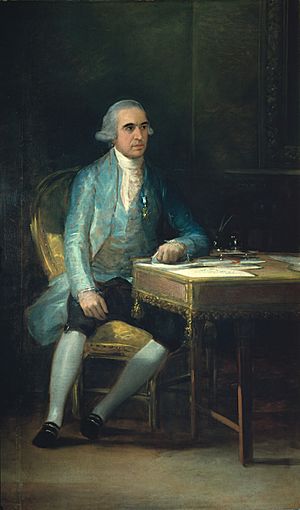Francisco Saavedra de Sangronis facts for kids
Quick facts for kids
The Most Excellent
Francisco Saavedra
|
|
|---|---|
 |
|
| Prime Minister of Spain | |
| In office 30 March 1798 – 21 February 1799 |
|
| Monarch | Charles IV |
| Preceded by | Manuel de Godoy |
| Succeeded by | Mariano Luis de Urquijo |
| Personal details | |
| Born |
Francisco Saavedra de Sangronis
|
| Nationality | Spanish |
Francisco Saavedra de Sangronis (1746 – 1819) was an important Spanish government official and soldier. He played a big part in helping the American colonists win their independence from Britain. His work in Cuba helped lead to key victories against British forces in Florida and at Yorktown.
Contents
Francisco Saavedra: A Spanish Leader
Early Life and Secret Missions
Francisco Saavedra was born in Seville, Spain, in 1746. He first studied to become a doctor. Later, he joined Spain's military and worked with Bernardo de Gálvez in a campaign in Algiers in the 1770s. Through Gálvez, he changed his career to work in the Spanish government's Ministry of the Indies. This department managed Spain's colonies. Saavedra mainly worked as a financial planner, helping to manage money.
In 1780, Saavedra was sent to Havana, Cuba. His job was to improve the Spanish government's work there. He also had a secret mission: to help Gálvez take Florida back from British control. On his way to the Caribbean, his ship was captured by the British. Saavedra pretended to be a simple merchant. This trick allowed him to move freely around Jamaica, which was a British island. The British didn't know that he had helped plan a Spanish invasion of Jamaica just two years earlier!
While in Jamaica, Saavedra used his freedom to learn all he could about the island's ports and defenses. He wrote in his diary in 1780 about the American Revolutionary War. He believed it would cause a "great upheaval" in the world. This shows he was a very thoughtful and smart person.
Helping Win the American Revolution
In January 1781, the British finally released Saavedra. He then started his work in Havana. He quickly suggested changes to how the government was run. Over the next few months, he helped plan and even took part in Gálvez's successful attack on Pensacola. Pensacola was a very important British base in Florida.
When Saavedra returned, he found that the Spanish government had accepted his ideas. Key officials had been replaced. In July, he met with Admiral de Grasse, a French naval commander. Saavedra spoke French very well. They met in the French colony of St. Domingue (now Haiti). They discussed the best ways to use the large French fleet that de Grasse had brought across the Atlantic.
Together, they created a plan known as the Grasse-Saavedra Convention. Their first goal was to help the French and American forces in the United States. They especially wanted to attack the British army in Virginia, led by Lord Cornwallis. This attack later became the famous Battle of Yorktown. Their next goal was to take back Caribbean islands that the British had captured. The final part of their plan was to capture Jamaica, which was Britain's richest colony in the West Indies.
To pay for the first part of the plan, Saavedra got 100,000 pesos from the Spanish treasury in Santo Domingo. The Spanish had planned to send more money from Mexico, but those ships hadn't arrived. Saavedra then found that most of Havana's government money had been sent to Spain. So, he asked the citizens of Cuba for help. In just a few hours, they raised another 500,000 pesos! This money was crucial for the American and French forces.
Later Years and Important Roles
While Admiral de Grasse carried out the plan, Saavedra spent months preparing for the invasion of Jamaica. However, the French fleet suffered a big defeat at the Battle of the Saintes in April 1782. This was a major setback, but preparations for Jamaica continued. By the end of 1782, the Spanish government decided to stop the plan. It seemed like it would be too expensive.
From 1783 to 1788, Saavedra worked as an intendant (a type of governor) in Caracas. After that, he returned to Spain. He became a member of the Supreme War Council. In 1797, he became the Finance Minister, managing the country's money. The next year, he became the Minister of State, a very high position.
However, his health was not good, so he soon retired to Andalusia. But he returned to service in 1810 when Napoleon's French forces invaded Spain. Francisco Saavedra died on November 25, 1819. He is remembered for his clever mind and his important role in helping the American colonies gain their freedom.
See also
 In Spanish: Francisco de Saavedra para niños
In Spanish: Francisco de Saavedra para niños


